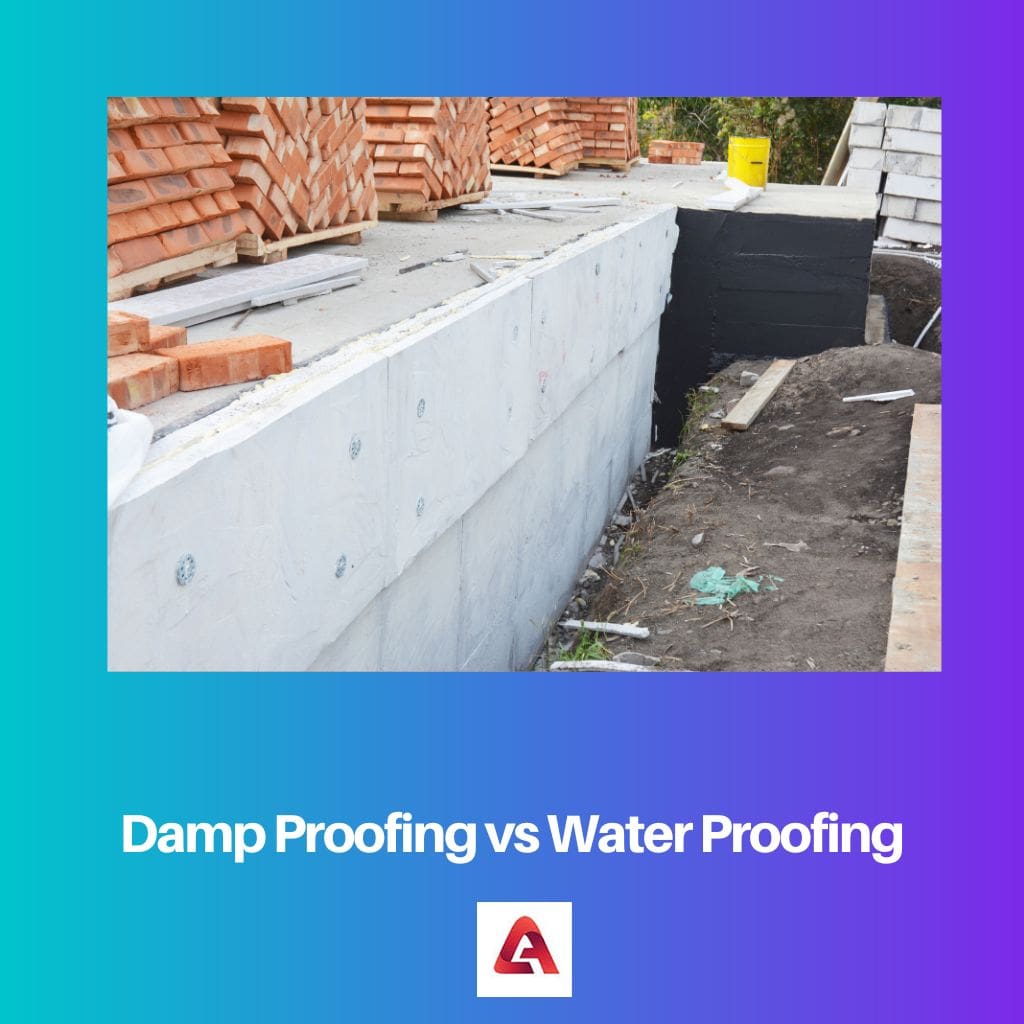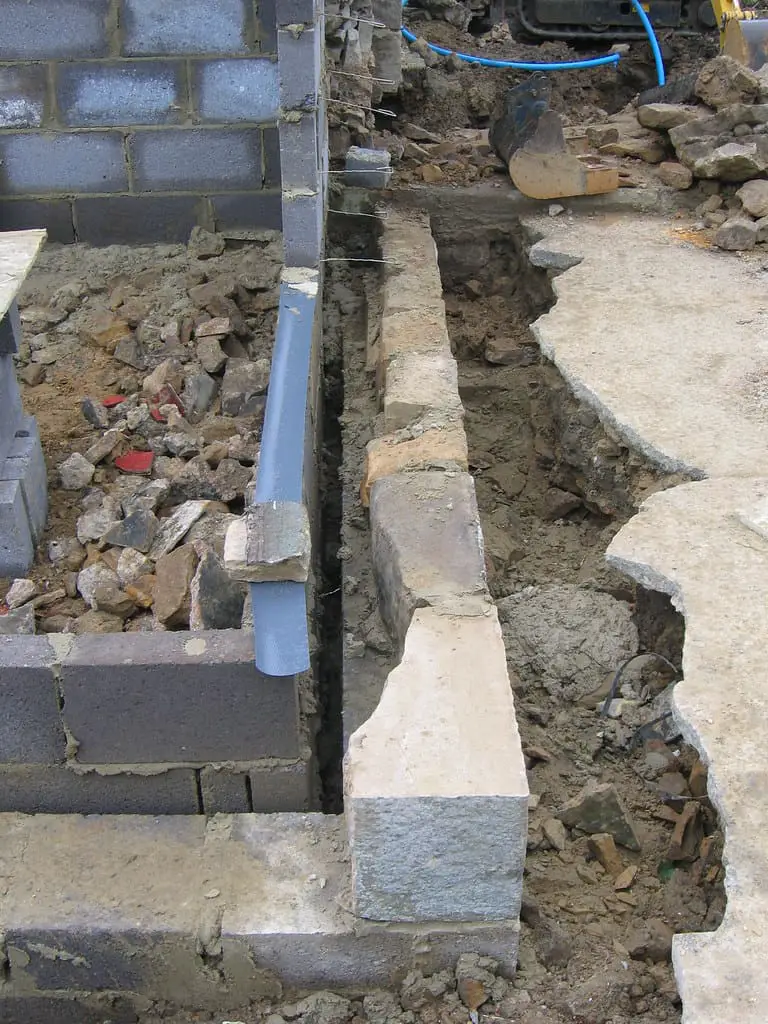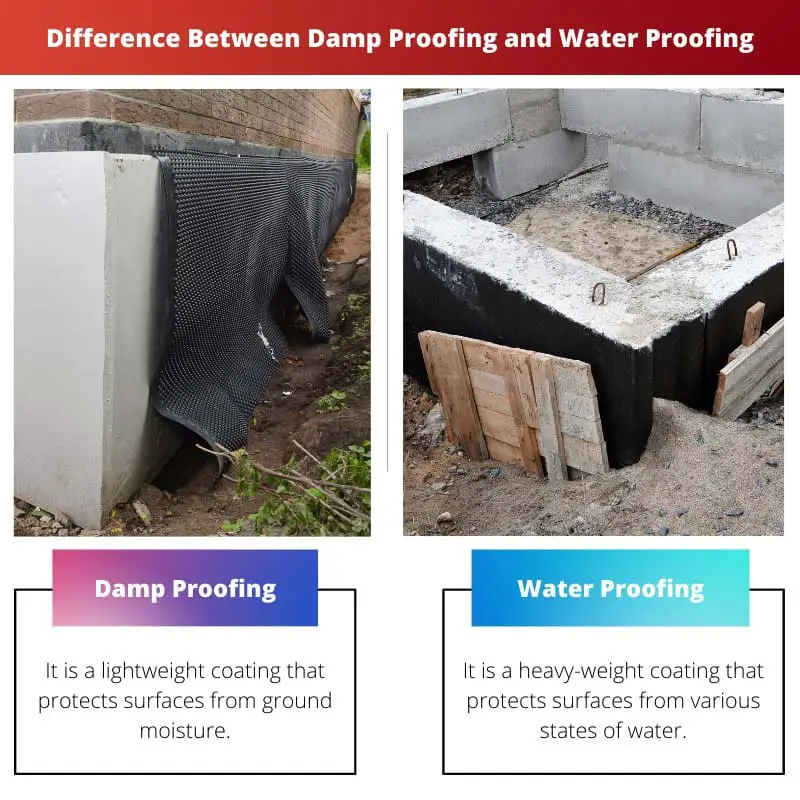Damp proofing and water proofing are two processes that are involved in construction. Their general objective is to protect surfaces from perils, one of which is moisture.
Due to this, they are confused with being the same thing. However, both are completely different in terms of the substances used, application dimensions, and usage advantages.
Key Takeaways
- Dampproofing prevents moisture from entering a building through walls or floors.
- Waterproofing is used to prevent water from penetrating a structure, such as a basement or a roof.
- Dampproofing is less expensive and can be done from the exterior or interior of a building, while waterproofing requires specialized materials and is done during construction.
Damp Proofing vs Water Proofing
The difference between damp proofing and water proofing is that damp proofing is only used on surfaces to prevent crack-ups caused due to the absorption of moisture; however, it cannot withstand hydrostatic pressure. On the other hand, water proofing is used to prevent moisture and water from entering surfaces. It can prevail against hydrostatic pressure easily.

Ground moisture is a huge problem for buildings that are always in direct contact with the earth. Damp proofing effectively stops this moisture from entering the walls.
It is a lightweight coating that must not be subjected to water or air pressure, or else it ruptures. Most treatments are done with an asphalt base.
Meanwhile, water proofing is used when damp proofing and drainage are not enough for protection. It shields a surface from various states of water.
Unlike damp proofing, it effectively withstands air and water pressure without hassle. This is a heavyweight coating that comprises several layers of asphalt-saturated felt that is mixed with tar or asphalt pitch.
Comparison Table
| Parameters of Comparison | Damp Proofing | Water Proofing |
|---|---|---|
| Function | It is a lightweight coating that protects surfaces from ground moisture. | It is a heavy-weight coating that protects surfaces from various states of water. |
| Effectiveness Against Pressure | It is not effective against water and air pressure. | It is effective against water and air pressure. |
| Material | It is made using an unmodified asphalt base. | It is made using asphalt-saturated felt mixed with tar or asphalt pitch. |
| Girth | It has less than 10 millimeters of thickness after curing. | It has a width of at least 40 millimeters after curing. |
| Underground stability | The coating is too delicate for low temperatures. | The coating is elastic and flexible even at low temperatures. |
What is Damp Proofing?
Damp proofing is a form of moisture control that is used during the construction of buildings. It is applied on walls and floors to stop moisture from entering the internal area of the architecture.
However, the coating is lightweight and cannot withstand hydrostatic pressure. Even though damp proofing can keep moisture out, it is not resistant to water vapor.
Various materials can be used for damp-proofing a wall. The most commonly used ones include hot asphalt, butyl rubber, bituminous felts, plastic sheets, lead sheets, and even copper.
These materials are flexible and easily applicable. Rigid materials such as impassive brick, slate, stone, and cement are also used in various cases.
Generally, most construction methods involve a damp-proof course (DPC) and a damp-proof membrane (DPM) for moisture control. DPC is a barrier applied on the surface either horizontally or vertically.
It is laid below masonry walls. Meanwhile, DCM is a membrane that can also be used along with DCP. It is sheeting laid under concrete slabs.
DPC is considered to be more effective than DCM. However, some materials that are used in this process may contain asbestos fibers.
These are harmful substances that may increase risks in terms of the health and safety of residents and construction workers.

What is Water Proofing?
Water proofing is the process of making surfaces resistant to water in various forms. It is done in wet environments or underwater up to certain depths.
Several layers of coating are applied, making the proofing heavyweight. This allows it to withstand water and air pressure without hassle.
The coating can be called a membrane that is created using various materials. Some of them involve tar, felt paper, and even asphalt mixed with tar.
Other unconventional but effective substances such as bitumen, ethylene-propylene rubber, liquid roofing, polyvinyl chloride, and Hypalon are also used in many cases.
The process is used on surfaces where damp proofing is insufficient. Most water proofing processes even involve damp proofing.
Either way, it is important to have water proofing in places where the humidity is high. This is because water seepage can give rise to problems such as mold growth, which also harm the surface and air quality.
Rooftops and balconies are important areas for which water proofing should be considered. Moreover, decks have the tendency to move when temperatures change.
This applies pressure on water proofing systems, which can turn out to be failed processes. Therefore, proper methods must be used to avoid any damage.
Main Differences Between Damp Proofing and Water Proofing
- Damp proofing is a lightweight coating that protects surfaces from ground moisture, whereas water proofing is a heavy-weight coating that protects surfaces from various states of water.
- Damp proofing is not effective against water and air pressure, whereas water proofing is effective against water and air pressure.
- Damp proofing is made using an unmodified asphalt base, whereas water proofing is made using asphalt-saturated felt mixed with tar or asphalt pitch.
- Damp proofing has less than 10 millimeters of thickness after curing, whereas water proofing has a width of at least 40 millimeters after curing.
- Damp proofing is too delicate for low temperatures, whereas water proofing is elastic and flexible even at low temperatures.




